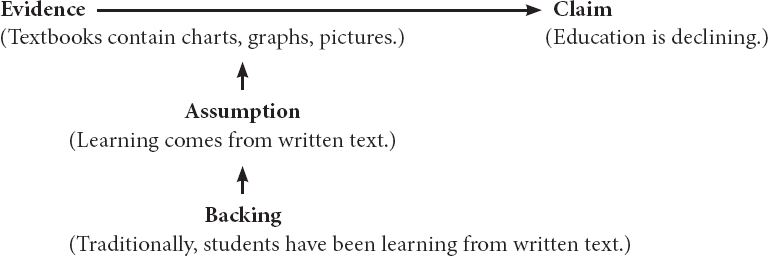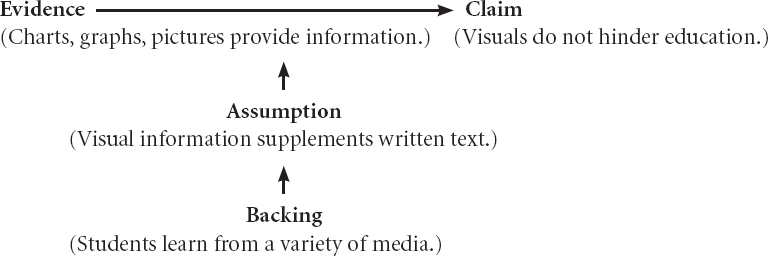From Reading to Writing
Printed Pages 129-131The Toulmin model can help you not only analyze the arguments that you read but also to bring logic and order to those that you write. Of course, the Toulmin language shouldn’t be used directly in your essays because it often sounds stiff and lacks the nuance of more natural writing. Eliminating some of the artificial constructions and awkward phrasings—because, therefore, since—can create a strong thesis statement, or at least help you think through the logic of your argument fully so that you can compose one that is strong and persuasive.
Let’s walk through the process of refining an argument topic using the Toulmin model. We’ll begin by responding to an argument about the increased visual nature of our print media, including textbooks:
One reason education in this country is so bad is that the textbooks are crammed full of fluff like charts and graphs and pictures.
Let’s restate this argument using the Toulmin model and look at its component parts, omitting the redundant “therefore.”
Because textbook authors are filling their books with charts, graphs, and pictures, therefore the quality of education is declining in this country, since less written information equals less learning.

Studying the argument this way, we find that the original argument has a vulnerability in that it assumes students only learn from printed text and not from visual material.
We can also use Toulmin to craft a response, using a simple template such as this: “Because ____________, (therefore) ____________, since ____________, on account of ____________, unless ____________.” Just because it’s a template doesn’t mean it has to tie your hands intellectually. You can put forth any viewpoint you like. Here is one response, just as an example (again, deleting the “therefore”):
Because charts, graphs, and pictures provide information, therefore they do not hinder the education system, since that information is a supplement to written text.
In this case, we did not include a qualifier or a reservation.

You would then use that statement to develop your position and to write the thesis for your essay. The following example presents the claim but doesn’t argue with the data: it acknowledges its validity, as far as it goes (this creates a reasonable tone and appeals to ethos and logos), and then zeros in on the assumption with a pair of rhetorical questions:
Much of the argument is indisputable; however, some of it can be interpreted in different ways. Take, for instance, the criticism of textbooks for using too many visuals, particularly of a map replacing a topographical description. Is the map really a bad thing? Are any of the charts and graphs bad things?
The essay would then go on to argue the value of visuals not as replacements for but as enhancements to written texts, developing a qualified and reasoned argument.